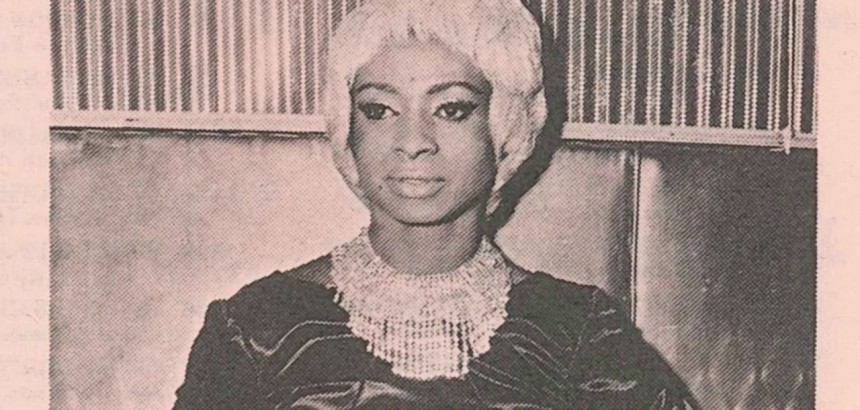Let’s make a canon! And let’s fill it with queer art, or queer-ish art, or art that has no idea how queer it is. Queer art is often secret art: black-market, whispered-about, read-between-the-lines art. And since secret art can be hard to find, let’s shine a light on a few of our favourite things so all our friends can see them.
We’ll call it a canon, because it sounds Weighty and Important and Serious, but we also won’t be too serious about it. We won’t make The Canon, just a canon. Each month, we’ll chat with a different queer-about-town and ask them to submit something to the canon. And they’ll tell us what that book or play or movie or TV episode or sculpture or poem or dance piece or opera or photograph or painting or performance art piece or anything else means to them and why they think it deserves a spot in our illustrious canon.
This month, we talked to visual artist and DJ Lauren Hortie about soul singer Jackie Shane.
So what were you thinking about submitting for our canon?
Well, I was thinking the 1998 film Wild Things…
Yes!
But then I was like, no I can’t; I’d have to re-watch and I have such a pure memory of it I think I’d better just leave it alone. So, one thing I thought I could talk about is Lavender Country, which is the first country album put out by a gay person. Or, I’m also super into Jackie Shane, who is a queer, black, cross-dressing soul singer in Toronto in the 1960s.
Both of those sound really cool! I’m up for either one.
I actually made a short film called Whatever Happened to Jackie Shane?—a short shadow puppet animation—a couple of years ago. He had this song… I say “he,” although I’m not sure what pronoun they would use now or how they would refer to themselves. But they had a song, it was Number 2 on the CHUM charts, and the chorus was “Tell her that I’m happy/ Tell her that I’m gay/ Tell her I wouldn’t have it any other way.” As in, tell my girlfriend that I’m over her.
That’s great!
And when they’d sing, you couldn’t really tell if they were male or female and they wore long, false eyelashes and sparkle jumpsuits and stuff.
And that was number 2 on the charts?
On the Toronto CHUM charts.
And probably went over everyone’s head, right?
My girlfriend Sonya’s mum has a story about being at a diner, one where they had the jukebox on the table, when she was a teenager. And she was with two gay male friends and that song came on and they had to explain it to her—the innuendo. And this was, I wanna say, 64?
That’s so early.
Way before Stonewall, before Gay Lib. So, just a little history: on Yonge Street in the 50s there was this kind of circuit of R&B and blues musicians who would come up from the states. And Jackie is from Tennessee originally and was a part of this circuit and somehow ended up in Toronto and stayed. And Toronto at the time was super square. A lotta really uptight morality laws and not a place that you might think “If I was a black, queer, feminine, soul-singing person, this would be the spot for me!” There’s one record, Jackie Shane Live, that you can find, and it was recorded on Yonge Street. You can hear them talking in between songs and the innuendo is right there. There’s a line where they talk about going out and picking up some “chicken.” “Cause I love chicken!” But “chicken” was slang for like young sex workers…
Sure, like “twinks.”
Yeah, “chicken” meant “young man.” So, they were using all these double entendres and all this language, but there was no way you would not know that they were a queer person. It’s kind of amazing to think of this image of them driving up and down Yonge Street in their Cadillac with their boyfriend and wearing these long false lashes and scarves and painted nails. And they were a really popular entertainer in Toronto!
That’s so cool! I’d never even heard of them before.
There’s some excellent stuff at the Lesbian + Gay Archives. They have these amazing tabloids, one in particular called Tab that ran in the 60s and ran the most sensational, gossipy headlines. My favourite is “Lesbian Vermin Plagues Toronto.” It’s about lesbian bars on Spadina, and these lesbians beating up men and stealing their wallets…
Oh my god, amazing!
But then you turn to page 3, and there are these gossip columns that had to have been written by a gay man. They’re like “I saw Johnnie leaving his apartment last night with a new fur. I guess he’s got a new daddy in town…” And there’s all these gossip items about “Miss S,” which is Jackie. So, it would be like “We saw that Miss S has an empty spot in her Cadillac. Wonder what happened to young so-and so.” So, it’s this outwardly intensely homophobic publication with this total insider track where, if you were gay, you could just skip to page 3 and there’s your community. While it’s being slandered on the front page.
I love finding out about these secret histories.
Super secret! Yeah, and with Jackie Shane, I was really lucky to find them. I was at a record show, digging through bins, and I found the Jackie Shane record. And the guy selling it was like “Oh, that’s from a Toronto drag queen.” And I was like “I will buy this.” And at the time, I think it was the most expensive record I’d bought; I think it was $20. (laughs) And now, I’m like “that was a really good investment.”
[For more about Jackie Shane, check out this CBC Radio doc.]



Jackie was a regular at the Sapphire Tavern at Richmond and Victoria for years , fronting Frank Motley & the Hitchhikers – as funky as the DAP Kings or James Brown’s Famous Flames. Did the first set dressed in male kit, and out came the wig and ballgown for set #2.
The gay scene was strong, but in pre-pride parade “keep your head down” Toronto fashion of the day.
Jackie went to #2 on the charts, but sadly the recording didn’t do his live show justice. They were dynamite, night after night. In those days, Thursday evening in particular was “boys night out” in the clubs.